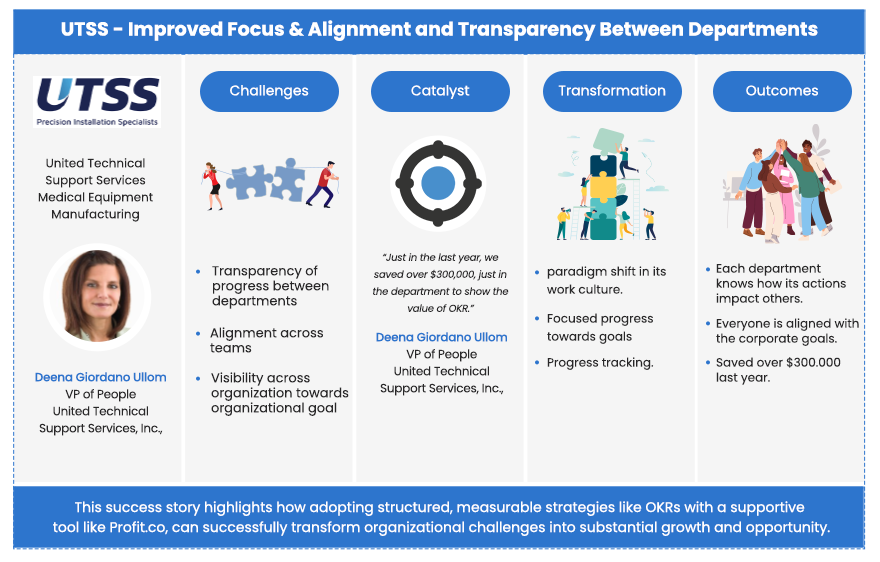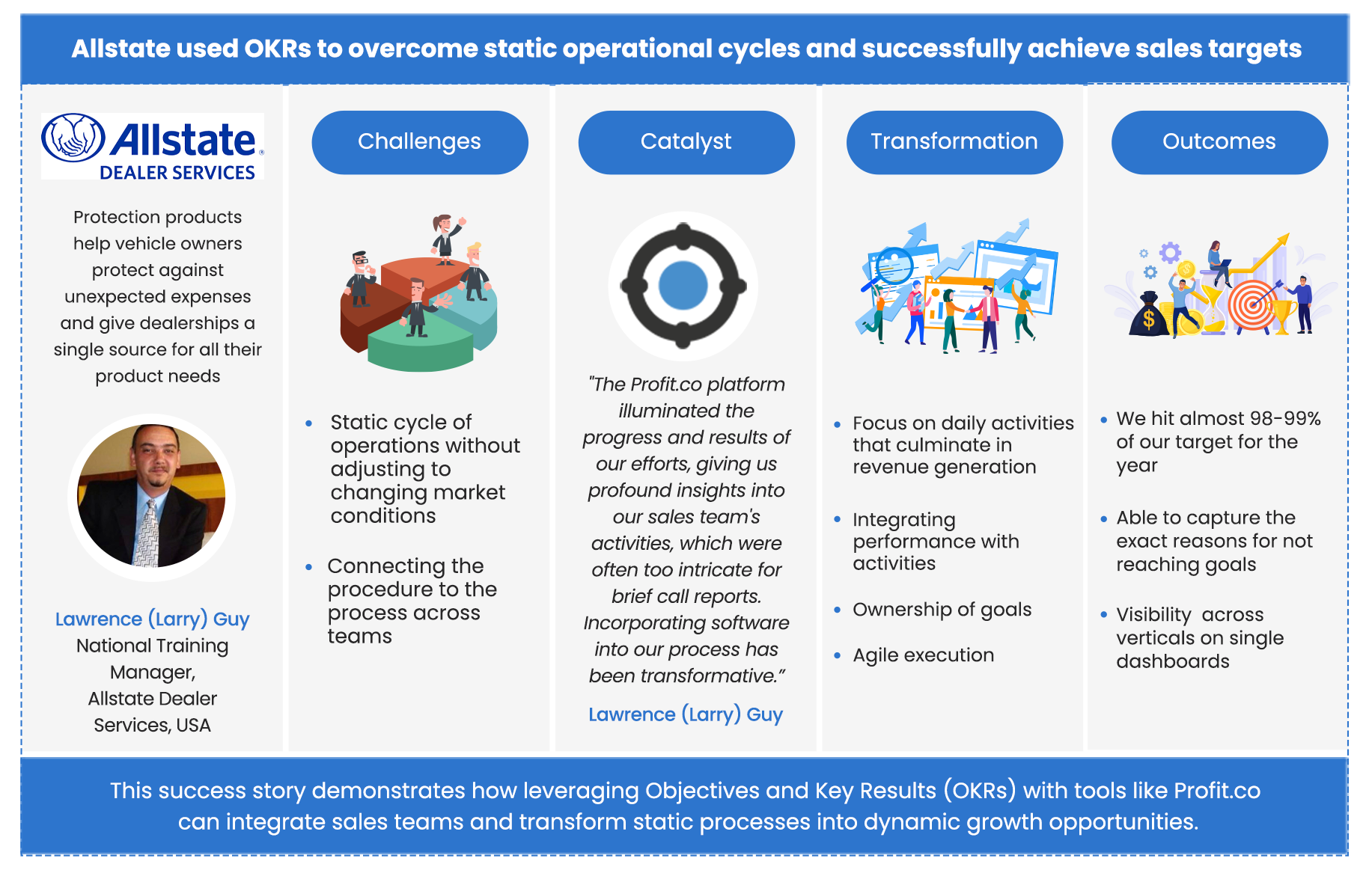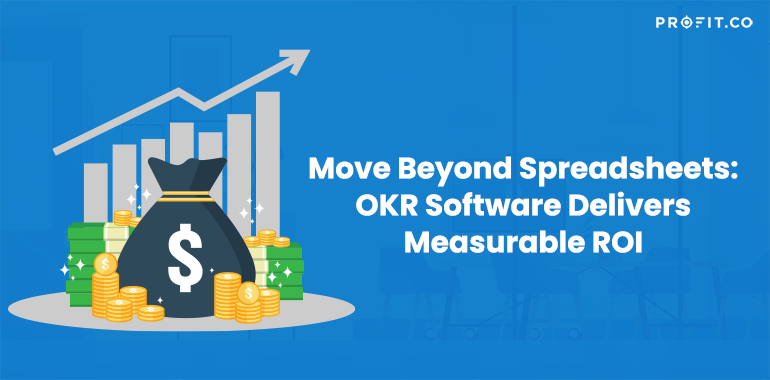The growing gap between strategic intent and operational execution necessitates clearly defined objectives and meticulous progress tracking. This is where OKRs (Objectives and Key Results) emerge as a powerful framework for goal-setting, utilized by industry leaders like Google and Spotify.
Everyone knows OKRs are awesome, right?
While smaller organizations might initially manage with spreadsheets, large organizations can face significant challenges in effectively implementing OKRs. For companies growing like crazy, setting them can fall by the wayside. Limited resources and a million other priorities keep getting in the way.
OKR software tools offer a compelling solution, promising substantial improvements in efficiency, organizational alignment, and, ultimately, a positive impact on your financial performance. But before diving in, let’s explore the concept of ROI (Return on Investment) and how it applies to software tools.
Evaluating the return on investment (ROI) for an OKR software tool involves assessing the potential benefits and costs associated with the technology. It is pertinent to note that the ROI evaluation can be complex, as it involves both tangible and intangible factors.
Additionally, the accuracy of ROI calculations depends on the accuracy of your cost benefit analysis. In some cases, it might be beneficial to engage financial experts with experience in evaluating technology investments to ensure a thorough analysis.
ROI
Simply put, it is the measure of profit or gain you receive from an investment. When considering software tools, ROI helps you understand the potential financial benefits compared to the initial cost. It’s a crucial decision-making tool, ensuring you invest in solutions that truly add value to your business.
Why is ROI crucial for software tools?
- Justifies Cost: ROI helps you convince stakeholders by demonstrating the financial benefits of the tool. It allows you to compare the cost of the software with the expected increase in revenue, cost savings, or other quantifiable improvements.
- Measures Effectiveness: Tracking ROI throughout the lifecycle of the software helps you assess its actual impact on your business. This ongoing evaluation allows you to adjust strategies and optimize tool usage to maximize value.
“If you want me to do things only for ROI reasons, you should get out of this stock.”
Hard vs. Soft ROI
Not all ROI is created equal. Let’s explore two key categories.
Hard ROI
This refers to quantifiable benefits that directly translate into financial gains. Examples include increased revenue, cost savings, and reduced errors.For instance, Sears Holding Company reported an 8.5% increase in average hourly sales after implementing OKRs, suggesting a significantly positive ROI.
Soft ROI
These benefits are qualitative and may not have a direct dollar value attached. However, their impact on employee morale, collaboration, and overall organizational health can be significant.
ROI of OKRs
To understand the ROI of OKRs, we need to compare the value delivered by teams working with OKRs to traditional success rates of projects. Even conservative estimates show a significant improvement. For instance, if a company has projects expected to deliver $20 million in new business annually, a conservative improvement of at least 10% in value delivered by using OKRs would mean an additional $2M to $4M for the year.
OKR Software and Hard ROI
By streamlining the goal-setting process, boosting transparency, and facilitating progress tracking, it can lead to
- Increased project completion rates with clearer goals , measurable key results, everyone on the same page, minimizing miscommunication and rework.
- By aligning individual and team objectives with company-wide goals, OKR software helps allocate resources more effectively towards impactful projects.
- Setting clear sales objectives and tracking results (e.g., conversion rates) can directly impact revenue generation.
OKR Software and Soft ROI: OKR software fosters a culture of transparency and accountability, leading to:
When employees understand company goals and see how their work contributes to them, they feel more engaged and motivated.
OKR software facilitates communication and alignment across teams, ensuring everyone works towards a common collaborative vision.
Data-driven insights from OKR software empower better decision-making at all levels of the organization.
Ready to start your OKR journey for FREE?
How do you calculate the ROI of an OKR software?
1. Identify Relevant Metrics
Track metrics like sales growth that can be attributed to improved goal alignment and focus from using OKRs. Measure cost savings from streamlined workflows (e.g., less time spent chasing down updates), fewer errors due to clear communication, and minimized rework. Monitor the percentage of projects completed on time and within budget due to better resource allocation and progress tracking facilitated by the software.
Conduct regular pulse surveys(short, frequent surveys) to track changes in employee sentiment towards goals, company direction, and overall satisfaction. Measure employee advocacy by asking “On a scale of 0-10, how likely are you to recommend this company as a place to work?” Track changes in eNPS after implementing OKR software. Integrate the OKR software with time tracking tools to measure the time saved on manual goal management tasks compared to spreadsheets or manual methods. Look for an increase in communication around goals and a decrease in confusion or miscommunication. Conduct focus groups with employees from different departments to gather qualitative feedback on collaboration and communication after implementing the OKR software. Look for anecdotal evidence or case studies within your organization highlighting how OKRs have sparked new ideas or innovative solutions.
2. Gather Baseline Data
It’s important to establish baseline data for all these metrics before implementing the OKR software. This allows you to compare against a benchmark and demonstrate improvement.
Focus on showing a trend of positive change in these KPIs after OKR software adoption.
3. Track and Monitor Performance
Once you have the OKR software in place, actively track and monitor the chosen metrics throughout a designated period (e.g., quarter or year).
4. Calculate ROI
Hard ROI
Use the ROI formula:
ROI = (Net Profit from OKR improvements / Cost of OKR software) * 100%
Net Profit here represents the increase in revenue or cost savings you measured.
Soft ROI
Assigning a dollar value to these benefits can be challenging. However, analyze the collected data (surveys, time saved) to demonstrate qualitative improvements that likely translate to financial benefits.
5. Consideration
It’s important to acknowledge that isolating the impact of the OKR software on specific metrics can be difficult. Other factors might influence some results. Set realistic goals for ROI based on industry benchmarks and company size.Consider conducting a pilot program with a small group before full company-wide adoption.Track employee adoption rates and satisfaction with the OKR software to ensure its effectiveness.
Real-World Success Stories: How Profit.co Transformed UTSS and Allstate
Profit.co’s OKR software isn’t just theory; it delivers real results. Here’s how it transformed UTSS and Allstate:
UTSS: Saved $300,000 in a Year.
“Implementing Profit.co streamlined our operations and fostered a culture of transparency and accountability. This transparency directly led to cost savings. In just the last year, we saved over $300,000 in the department, showcasing the value of OKRs,” says Deena Giordano Ullom, VP of People Operations at United Technical Support Services, Inc.

Allstate: 98-99% Target Achievement Rate in 2022.
“Reflecting on the past two years since implementing Profit.co’s OKR framework, we saw phenomenal success with OKRs in 2022. Quantitatively, we hit almost 98-99% of our targets for the year. This achievement was possible because we tracked our strategic initiatives using the quarterly OKR cycles,” shares Lawrence Guy, National Training Manager at Allstate Dealer Services. This impressive feat wasn’t just about hitting numbers; it translated to stronger sales strategies, a more cohesive team, and, ultimately, a boost to their bottom line.

Conclusion
By combining these quantitative and qualitative metrics, you can build a stronger case for the ROI of your OKR software investment, highlighting its impact on employee morale, collaboration, and, ultimately, business performance. Despite its limitations, ROI remains a fundamental measure of profitability and is a crucial tool in any investor’s toolbox. It’s a simple, quick, and versatile way to consider the profitability of an investment. However, it should be used alongside other metrics and information for a more complete picture of an investment’s potential.
Learn more about achieving continuous learning for your organization with Profit.co today
Related Articles
-
Profit.co is FedRAMP Ready. Trusted Execution for Federal Agencies Just Got Simpler
In a world where data security, compliance, and mission success are non-negotiable, Profit.co stands out as a trusted partner for... Read more
-
Tim Newbold: Drive OKR Outcomes with Confidence Scoring
You're not alone if you're unsure how confident your team is about achieving its OKRs this quarter. Many teams operate... Read more
-
Tim Newbold on Leading Outcome-Obsessed Teams with OKRs
In many team meetings, a recurring pattern emerges Team members provide updates such as, “I completed tickets 247 and 248,”... Read more
-
How Top Teams Win with Weekly OKR Check-Ins – Insights from Tim Newbold
Set a goal. Cross your fingers. Hope for the best.Sounds familiar?That’s how too many teams treat OKRs. They set goals,... Read more

